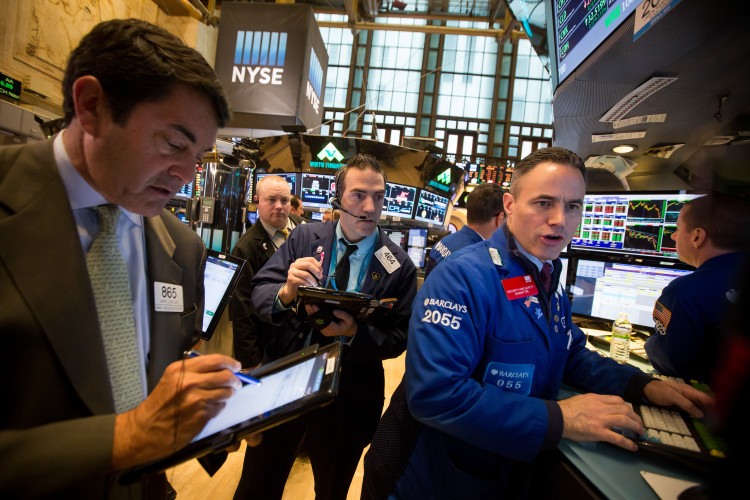S&P 500 Slips From 10-Month High as Banks, Commodity Shares Fall

published Jun 9th 2016, 3:45 pm, by Anna-Louise Jackson
(Bloomberg) —
U.S. stocks edged lower, with the S&P 500 Index slipping from a 10-month high, as investors evaluated the gauge’s run toward a record amid lingering concerns about the impact of lackluster global growth.
Equities staged an afternoon rebound as raw-material producers and banks trimmed losses, while defensive shares including utilities and phone companies rallied to offset those declines. Lenders and commodity shares closed above their worst levels, even as Treasury yields fell to the lowest since February and the dollar rebounded. Gains in Apple Inc. and Johnson & Johnson’s 1 percent climb to a record also contributed to the late-day recovery.
The S&P 500 retreated 0.2 percent to 2,115.48 at 4 p.m. in New York, after losing as much as 0.5 percent. The gauge closed closed 0.7 percent from a record. The Dow Jones Industrial Average lost 19.86 points, or 0.1 percent, to 17,985.19. The Nasdaq Composite Index declined 0.3 percent. About 6.1 billion shares traded hands on U.S. exchanges, 13 percent below the three-month average.
“With the market being priced where it’s at, there’s not a lot of room for air because valuations are so high,” said Jim Davis, regional investment manager at the Private Client Reserve of US Bank, which oversees $128 billion. “I would not be surprised to see it back off a little more in the next week. The market has to navigate some choppy waters between now and mid-July, with the Fed next week and the Brexit vote the following.”
Crude oil dropped for the first time in four days as the dollar bounced from a one-month low, weighing on energy producers. Raw-material and energy shares have paced equity gains this week amid the currency’s post-payrolls selloff, and the two groups have been pillars in a rebound that’s lifted the S&P 500 more than 15 percent from an almost two-year low in February.
Optimism that low rates and modest growth are a perfect recipe for stock gains cooled before of a series of events that could set a less bullish tone in financial markets. The looming Federal Reserve meeting, followed by the Brexit vote and U.S. political conventions have the potential to roil markets, and with stocks at multimonth highs, there’s diminished incentive to push prices further.
Word that billionaire investor George Soros recently oversaw a series of big, bearish investments is also contributing to the tempered mood. A person familiar with the matter said Soros has become more involved in trading at his family office, concerned about the outlook for the global economy and the risk that large market shifts may be at hand.
A stock rally picked up pace in the past few weeks after losing momentum following a four-month high on April 20. The S&P 500 declined Thursday after three days of gains, the longest in a month, and had climbed in eight of the prior 11 sessions. Still, the index has struggled to hold onto advances beyond the 2,100 level in prior rallies during the past year.
Narrow Moves
The benchmark has failed to move more than 0.5 percent up or down for 10 consecutive sessions, the longest such streak since September 2014. That’s come amid lighter-than-average volume. Through Thursday, the period of tepid gains and declines saw daily trading average 6.5 billion shares, 12 percent lower than the one-year average and almost 30 percent below the average during a six-week rout that started the year.
While equities fell last Friday after a disappointing jobs report, support this week has come from Federal Reserve Chair Janet Yellen’s remarks that the U.S. economy is making progress and indications that policy makers won’t rush to raise interest rates. Traders have cut back their bets for a Fed rate increase, now pricing in no chance of a boost in June and only 20 percent probability in July. December is the first month with at least even odds of a rate increase.
Bolstering Yellen’s belief that the economy will continue to improve, a report today showed first-time jobless claims unexpectedly fell last week and the number of Americans already receiving benefits tumbled to an almost 16-year low, consistent with a healthy labor market.
“The S&P 500 has had a remarkably steady run over the last three weeks in particular,” said Michael Ingram, a market strategist at BGC Partners in London. “Still, the global economy is not in good shape. And while the last payroll report may be dismissed as an aberration, confidence in the U.S. recovery has clearly been shaken.”
VIX Climbs
The CBOE Volatility Index rose 4 percent to 14.64, a two-week high. The measure of market turbulence known as the VIX is headed toward a second straight weekly climb and the fourth in the last five.
In Thursday’s trading, seven of the S&P 500’s 10 main industries fell. Financial and raw-materials shares lost more than 0.6 percent, trimming early declines of at least 1.1 percent. Utilities rose the most, followed by phone companies and consumer staples, which were buoyed by J.M. Smucker Co.’s 7.9 percent rally to a record. The company’s quarterly results topped analysts’ estimates, helped by pet food and Dunkin’ Donuts-branded coffee pods.
Banks in the benchmark were the biggest drag on financial stocks as the group alternated between daily gains and losses for the sixth session. Lenders fell to a two-week low, with KeyCorp and Comerica Inc. among the biggest decliners, losing more than 1.9 percent. Elsewhere in financials, asset managers Legg Mason Inc. and Affiliated Managers Group Inc. slid at least 2.5 percent.
Materials Slip
Raw-materials producers fell from an almost 11-month high, halting the group’s longest winning streak since October. Freeport-McMoRan Inc. slid 5.9 percent, while fertilizer makers CF Industries Holdings Inc. and Mosaic Co. dropped 4.2 percent and 1.8 percent, respectively.
Utilities advanced 0.9 percent, extending an all-time high as falling Treasury yields made the group’s relatively generous dividend payout more attractive. Ameren Corporation added 2.4 percent while Consolidated Edison Inc. and PG&E Corp. gained 1.5 percent. Utilities have the best year-to-date performance among the S&P 500’s main industries, rising 16 percent.
While most of the benchmark’s energy companies retreated, some natural gas producers rallied to help trim the group’s losses as the commodity surged to a nine-month high after a smaller-than-estimated supply gain signaled production declines. Cabot Oil & Gas Corp., Southwestern Energy Co. and Range Resources Corp. all gained at least 3.4 percent.
Among shares moving on corporate news, Restoration Hardware Holdings Inc. tumbled 21 percent to an all-time low after the upscale furniture chain posted a surprise loss and cut its annual forecast.
–With assistance from Aleksandra Gjorgievska. To contact the reporter on this story: Anna-Louise Jackson in New York at ajackson36@bloomberg.net To contact the editors responsible for this story: Cecile Vannucci at cvannucci1@bloomberg.net John Shipman, Namitha Jagadeesh
–With assistance from Aleksandra Gjorgievska. To contact the reporter on this story: Anna-Louise Jackson in New York at ajackson36@bloomberg.net To contact the editors responsible for this story: Cecile Vannucci at cvannucci1@bloomberg.net John Shipman, Namitha Jagadeesh
copyright
© 2016 Bloomberg L.P







No Comment